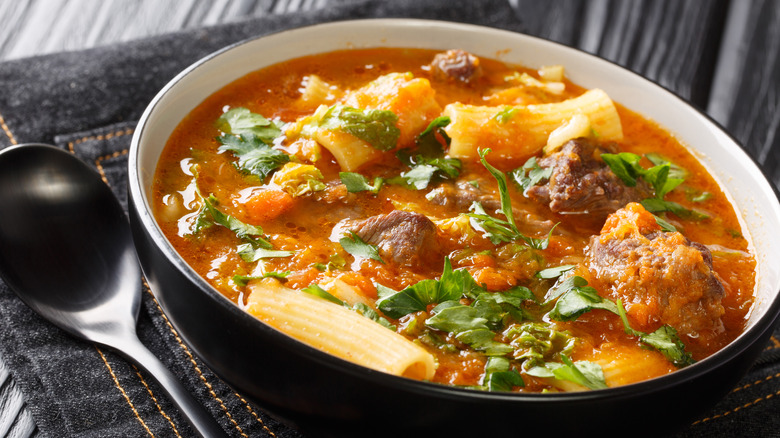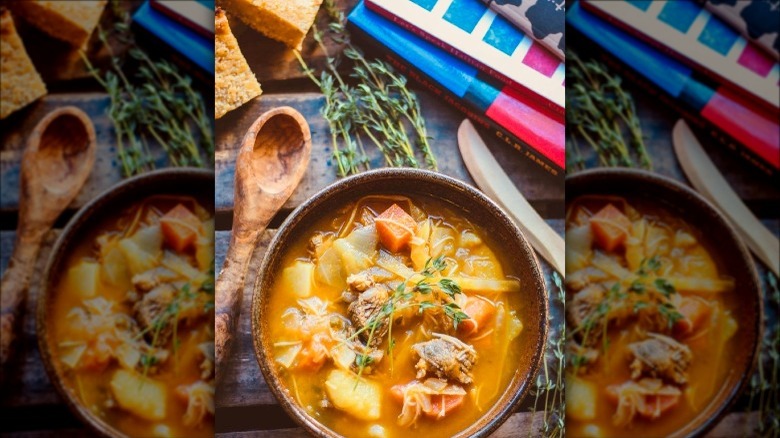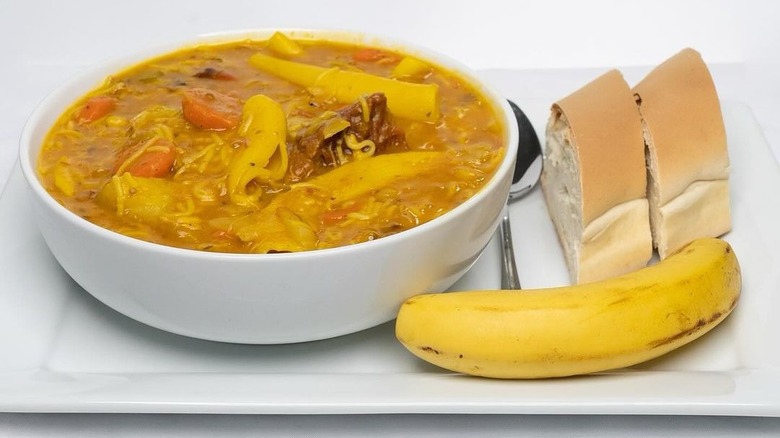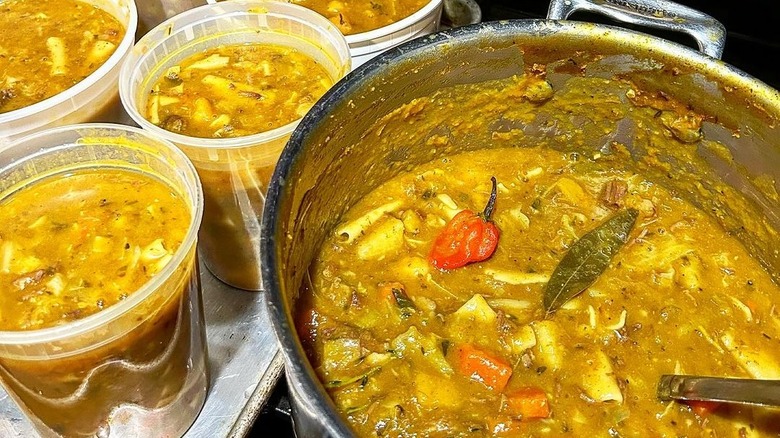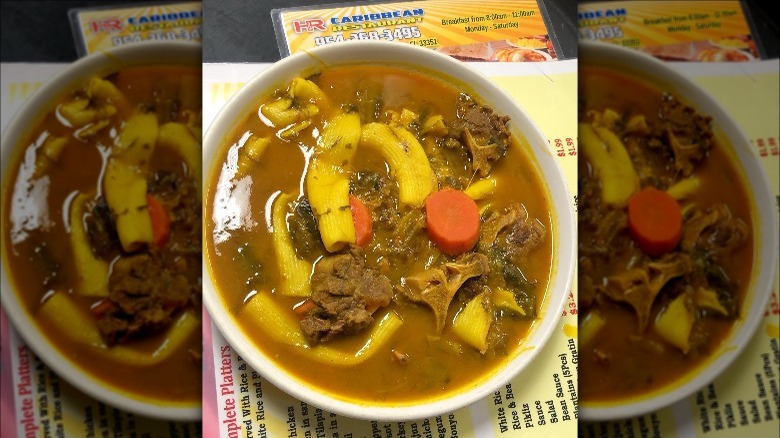Soup Joumou: The Rich Haitian Dish With A History To Match
Soups are typically — although not always — named for a chief ingredient (Italian wedding soup contains neither brides nor grooms). Soup joumou is no exception. If you translate the second word from Haitian Creole into English, you learn that it means pumpkin, and this is the soup's main ingredient. The dish also goes by a few other monikers, though, including "freedom soup" and "revolution soup," and thereby hangs a tale.
Just what is so revolutionary about the soup? Believe it or not, its main ingredient. Back when African-descended Haitians were enslaved by French colonists, the slave owners would not allow them to eat foods that were considered desirable, and pumpkin fell into this category. When the slaves won their freedom and Haiti declared its independence in 1804, it was seen as a symbol of their triumph to dine on this forbidden fruit (sas you may recall, a pumpkin technically falls into this category). Legend has it that Marie-Claire Heureuse Félicité Bonheur Dessalines, who briefly reigned as Haiti's empress, actually handed out the soup to her subjects with her own two hands. Whether this really happened, or it's just Haiti's version of George Washington chopping down that apocryphal cherry tree, it certainly does make for an inspirational story, and the soup itself sounds pretty tasty, too.
When is soup joumou eaten?
While soup joumou can be eaten at any time of year, it fits the profile of a cold-weather dish with its hearty root vegetable base and chunks of beef (although the beef may be optional since some claim that the dish was meant to be meat-free). It's fairly labor-intensive, too, as the prep work and cooking can take several hours. This indicates that it's a special occasion meal. As it just so happens, there is one winter holiday that soup joumou is particularly associated with, namely New Year's Day.
Unlike New Year's food superstitions that revolve around a symbolic connection to health, wealth, and general good luck, soup joumou is eaten for patriotic reasons. January 1 in Haiti marks not just the first day of the new year, but the anniversary of the independent, slave-free republic so it's kind of like the Fourth of July, Juneteenth, and New Year's all rolled into one. Soup joumou is de rigueur for any proper celebration — as UNESCO put it when adding the soup to its Representative List of the Intangible Cultural Heritage of Humanity, the dish "promotes social cohesion and belonging among communities." As such, it's the first meal of the new year, although many will indulge in multiple bowls throughout the day. In fact, one year a clinic in Massachusetts saw an influx of patients suffering from digestive distress, and upon investigation, it turned out that all of them had overindulged in soup joumou.
What goes into soup joumou?
While part of the fairytale history of soup joumou involves Empress Dessalines (if we may be permitted to shorten her lengthy appellation) hand-selecting each and every ingredient in soup joumou for symbolic reasons, 220+ years later there doesn't seem to be any one definitive recipe ... or does there? One volunteer with the Fondation Marie Claire Heureuse Félicité Bonheur Dessalines (they're not so big on name-shortening) claims that they learned the Empress' own recipe during a soup-making stint and insists it isn't made with any type of meat. Today, however, beef is a typical ingredient, so much so that some people feel that the only "true" soup joumou is a meaty version. Restaurants may cover their bases by choosing to make both types, though, and families with both meat eaters and vegetarians may do likewise.
In addition to the pumpkin and beef (or not beef), the soup typically contains other vegetables such as green beans, potatoes, turnips, onions, leeks, and bell peppers as well as some type of noodles or pasta. It may also be heated up with habaneros or scotch bonnets and seasoned with either epis or pikliz. These two condiments typically contain both aromatics and peppers, but the latter is spicier and also includes shredded cabbage and vinegar.
Soup joumou takes a lot of work
Making soup joumou can be quite a labor of love, with an emphasis on labor. One account of the cooking process involved girls from a youth center who worked all night long to chop all of the vegetables necessary to cook enough soup for 40 people. (They were allowed to take turns sleeping in shifts, however, as otherwise, the story would be more horrifying than heart-warming.) Other tales involve extended families or community organizations getting together to share all of the soup-making chores. Not only do many hands lighten the load, but working together also allows for plenty of time to socialize.
Should you choose to make soup joumou as a solo project, however, the soup itself takes maybe two to three hours to cook, but you'll need to spend quite a bit of time on the prep work. Some recipes may contain almost 40 ingredients, many of these vegetables or herbs that will need some sort of peeling, slicing, or dicing. There may also be meat that needs marinating or pikliz that needs pickling before everything can go in the pot to simmer. This means that if you do plan to eat this for breakfast on the first day of the year, you'll probably need to devote a good chunk of your New Year's Eve to soup making.
Where to try soup joumou
While many accounts of soup joumou make it sound like the kind of dish that can only be prepared at home, solo diners need not be relegated to hours of tedious work in order to participate in this New Year's tradition. A number of restaurants do offer the dish, although many only have it as an occasional special.
Brooklyn-based Bon Bon Lakay, while it doesn't offer a dine-in experience, does have soup joumou available for pickup or delivery during the last two days of the year. H & R Grill in Sunrise, Florida has also sold soup joumou on New Year's Eve, although it's not on the regular menu. Guigui's Kreyol Flavors in Clarksville, Maryland lists it as a seasonal offering that is only available for a limited (albeit unspecified) period of time. The Fancy Buffet Haitian Restaurant in Spring Valley, New York, has soup joumou every Sunday, as does Canzy Island Taste in Deer Park, New York. Chez Guyto in Miramar, Florida, however, lists it on the menu with no such disclaimers, so it seems to be available on a daily basis at this establishment.
